
Home » Measuring Proportions and Finding Landmarks
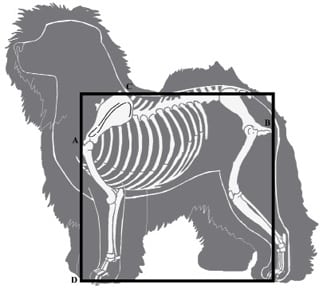
Measuring Proportions and Finding Landmarks
What is the first thing a judge does once a class is in the ring and checked in? He or she “walks the line” to get a first impression of the dog’s profile.
If you are not sure of the essential physical characteristics that make up your breed, you may find some hints in the first paragraphs of your breed’s AKC Standard under the heading of General Description. The next paragraph that I turn to in my studies of a new breed is usually the section on Size, Proportion and Substance. Please note that not all standards have this section separated from the whole of the standard, so you may have to hunt for the information.
In the late 1980s, AKC decreed that all Breed Standards be formatted in a particular order from that point forward. Only breeds recognized prior to 1989 could have revisions made to their Standards without reformatting, and any newcomers must use the format now in use. The majority of parent clubs went along with the new format and were allowed to reformat their Standards without making any actual changes to the wording, but a few declined and remain as they were.
The proportions of a dog are vital to their breed character. Their profile gives you the shape of the dog—so that most breeds can be identified by their silhouette alone. Proportions can vary widely from breed to breed, as do size and substance. But when describing the silhouette of the dog, the Standard usually (but not always!) explains height, weight, and proportion. When studying proportions in different breeds, there is usually a reference to particular points in the dog that are used as the basis for measurements. I call these particular points “landmarks.”
These landmarks vary from breed to breed and it is up to the breeder to learn how to find these landmarks so that they can determine the proportions in their own animals. Let us first discuss some of these landmarks and, more specifically, where they are located on the dog.
“Size, Proportion, Substance: The Shetland Sheepdog should stand between 13 and 16 inches at the shoulder. Note: Height is determined by a line perpendicular to the ground from the top of the shoulder blades, the dog standing naturally, with forelegs parallel to line of measurement.
Disqualifications – Heights below or above the desired size range are to be disqualified from the show ring. In overall appearance, the body should appear moderately long as measured from shoulder joint to ischium (rearmost extremity of the pelvic bone), but much of this length is actually due to the proper angulation and breadth of the shoulder and hindquarter, as the back itself should be comparatively short.”
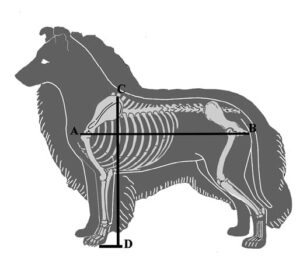
Please note that the landmarks to determine the length of the Sheltie are the shoulder joint, also called the point of shoulder (“A” on Figure 1) to the ischium, also called the pin bone (“B” on Figure 1) and from the top of the shoulder blades (“C” on Figure 1) to the ground (“D” on Figure 1).
The shoulder joint is the joint formed where the shoulder blade (scapula) meets the upper arm (humerus). It is considered to be a fixed point on the dog’s body. Unfortunately, the shoulder blade is not a fixed point—if the dog is more upright in shoulder, the topmost part of the shoulder blade is moved forward, making the dog measure longer.
When measuring a dog, one usually uses the highest point of the withers, which is composed of the first nine thoracic vertebrae and is a fixed point. The highest point of the withers is usually one of the first four thoracic vertebrae. Therefore, the measurement landmarks for the Shetland Sheepdog are the shoulder joint, the pin bone, and the top of the shoulder blade.
“Size – The preferred height for males is 20 to 23 inches, females 18 to 21 inches. Quality is not to be sacrificed in favor of size. Proportion – Measuring from the breastbone to rear of thigh and from top of the withers to the ground the Australian Shepherd is slightly longer than tall.”
On the Australian Shepherd, the measurement is from the breastbone (prosternum) (“A” on Figure 2) to the rear of the thigh (“B” on Figure 2), which is commonly referred to as the pin bone or scientifically as the ischiatic tuberosity. The breastbone (prosternum) projects forward of the shoulder joint or point of shoulder and is a fixed point, as is the pin bone in the rear.
The height of the dog is measured from the top of the withers (“C” on Figure 2) to the ground (“D” on Figure 2). Therefore, the measurement landmarks for the Australian Shepherd are the breastbone, the pin bone, and the withers.
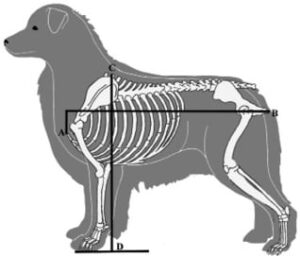
What we can see in comparing these two breeds is that even though they use different points of reference, they basically have the same proportions in both: slightly longer than tall.
“Type, character and balance are of greater importance and are on no account to be sacrificed to size alone. Size – Height (measured from top of withers to the ground), Dogs: 22 inches (55.8 centimeters) and upward. Bitches: 21 inches (53.3 centimeters) and upward. Proportion – Length (measured from point of shoulder to point of ischium (tuberosity) practically the same as the height. Absolutely free from legginess or weaselness. Substance – Well muscled with plenty of bone.”
The Old English Sheepdog is a square dog. The measurement landmarks are the wither (“C” on Figure 3), the point of the shoulder, at the shoulder joint, (“A” on Figure 3), and the ischium tuberosity or pin bone (“B” on Figure 3). The measurement is “practically the same,” and therefore, square. So, the measurement landmarks for the Old English Sheepdog are the point of shoulder to the end of the ischium (pin bone), and the withers.
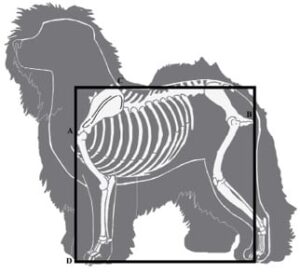
“Overall balance is more important than absolute size. Dogs and bitches should be from 10.5 to 12.5 inches at the withers when standing naturally. The ideal length/height ratio is 1.8:1 when measuring from the point of the breast bone (prosternum) to the rear of the hip (ischial tuberosity) and measuring from the ground to the point of the withers. Ideally, dogs should be from 30 to 38 pounds; bitches from 25 to 34 pounds. Lack of overall balance, oversized or undersized are serious faults.”
As a dwarf breed, the Cardigan Welsh Corgi has a normal-sized head and body, but shortened limbs. The breed is decidedly rectangular in profile. Length is measured from the breastbone (prosternum) (“A” on Figure 4) to the rear of the hip/ischial tuberosity or pin bone (“B” on Figure 4). The height is from the highest point of the withers (“C” on Figure 4) to the ground (“D” on Figure 4).
Using these landmarks to measure, the Cardigan is nearly twice as long as it is tall. Therefore, the measurement landmarks for the Cardigan Welsh Corgi are the breastbone (prosternum), the ischial tuberosity (pin bone), and the withers.
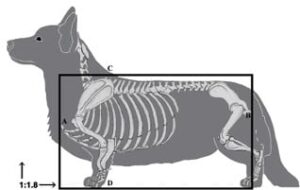
What I am trying to point out with these illustrations is that the landmarks used to measure the height and length of a dog can vary from breed to breed. The height is measured in the same way, no matter the breed, by using a wicket. The point (landmark) at which the measurement is determined can vary somewhat, as we have seen in the examples given, depending upon the point at which the height is to be determined. A fixed point gives a far more accurate measurement. The fixed point in this case, the wither, is composed of the first three to four thoracic vertebrae along with muscle and coat.
To be even more specific, it is the spine of the vertebrae that serves as this particular landmark. A correctly placed shoulder blade results in a wither that blends smoothly into the back. The (highest) point of the shoulder blade (scapula) is also used in a few of the Herding breeds as the uppermost measurement for height in the Collie, German Shepherd Dog, Norwegian Buhund, and Shetland Sheepdog.
Unfortunately, the shoulder blade can be attached to the thorax in differing positions, from well-laid-back (approximately a 45-degree angle to the ground) to more upright positions, which may also be moved forward on the thorax; therefore, not a fixed point. All other Herding breeds use the fixed point of the highest part of the withers for the measurement of height.
In Part Two, I will discuss how to find and palpate the landmarks used when going over a dog.
